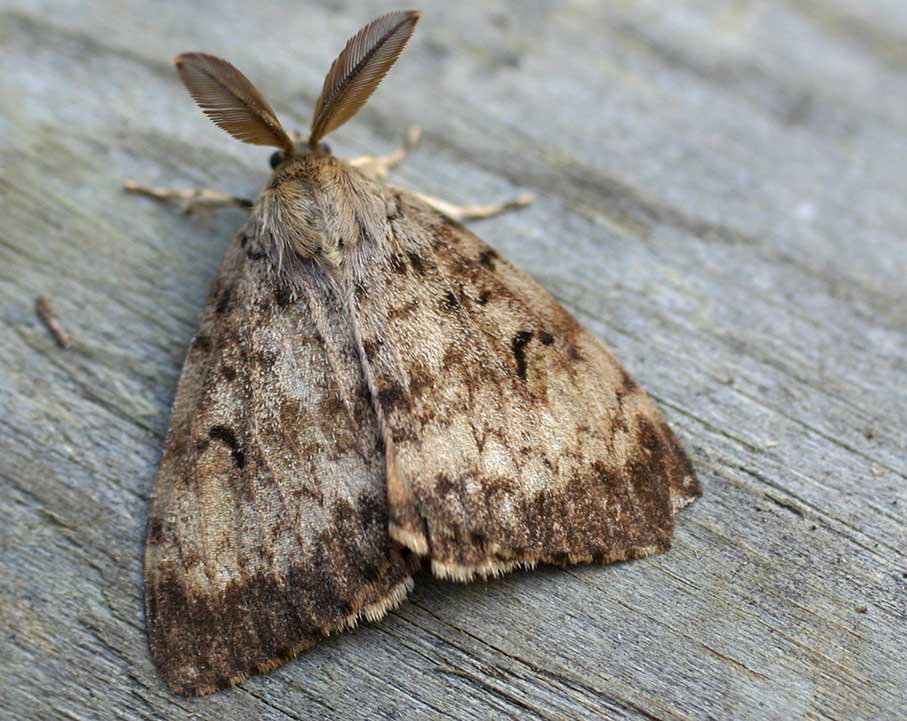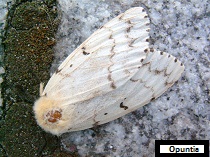Spongy moth (formerly referred to as gypsy moth) in British Columbia
Get the latest news about the status of current treatment operations
The European spongy moth (Lymantria dispar; formerly referred to as gypsy moth) was introduced from Europe to the northeastern U.S. in 1869. The North American strain of the moth was first seen in B.C. in 1978.
On this page
Spongy moths are defoliators, which means their caterpillars eat the leaves of trees and shrubs.
- Biology and identification of spongy moths
- Learn to identify whether a caterpillar is a spongy moth caterpillar
Once spongy moths arrive in an area, they threaten extensive damage to the environment and economy. B.C.'s major trading partners may set quarantine and trade restrictions, and restrict transportation for products like Christmas trees and logs with bark. For example, in 1999, in response to a spongy moth infestation, the U.S. threatened to refuse shipments from B.C. nurseries without additional inspection certificates.
The spongy moth threatens B.C. fruit producers. It will eat the leaves of fruit and hazelnut trees, and blueberry plants. Apple trees, in particular, are excellent hosts. But the insect has more than 300 known hosts, including native shade trees, the rare and endangered Garry oak and valuable ornamental trees.
Management
In B.C., the goal of spongy moth management is “eradication” — to prevent populations from becoming established. Spongy moths are not yet established in B.C. or in adjacent areas in western Canada and the western United States.
Canadian and U.S. agencies have striven to find and eradicate this invasive pest. As a result, while spongy moth populations are found in B.C. every year, so far the insect has not become permanently established.
An established population is defined by the North American Plant Protection Organization as one that is perpetuating "for the foreseeable future within an area after entry."
Eradication
In B.C., the spongy moth eradication strategy involves three main steps:
- Prevention — Preventing spongy moths from entering B.C. is always better than having to eradicate them once they are established.
- Monitoring — Pheromone traps are used to monitor and detect new introductions, and to monitor the success of treatments.
- Treatment — Methods are designed to eradicate an introduced population quickly while it is still very small.
Trapping and treatment
The most common treatment is to spray with the biological insecticide Btk. Other methods are also used.
Since 1997, the spongy moth has been trapped in many locations across the Lower Mainland, Vancouver Island and B.C.'s southern Interior. B.C.'s first spraying occurred in 1979.
Read what HealthLinkBC says about spongy moth spraying:
- HealthLinkBC's spongy moth spraying information
Spongy moth treatment update:
To find out more:
- Call the spongy moth 24-hour information line: 1-866-917-5999
- Subscribe to the spongy moth news page for email updates

Adult male spongy moth

Adult female spongy moth
Review the spongy moth life stages. If you find any of these life stages, please contact the Canadian Food Inspection Agency (CFIA) as soon as possible. An inspector will investigate.
- 250-363-3618
(Vancouver Island) - 604-292-5641
(Mainland/Interior)
Contact information
Contact us if you have further questions about the spongy moth or how the species is controlled in B.C.
